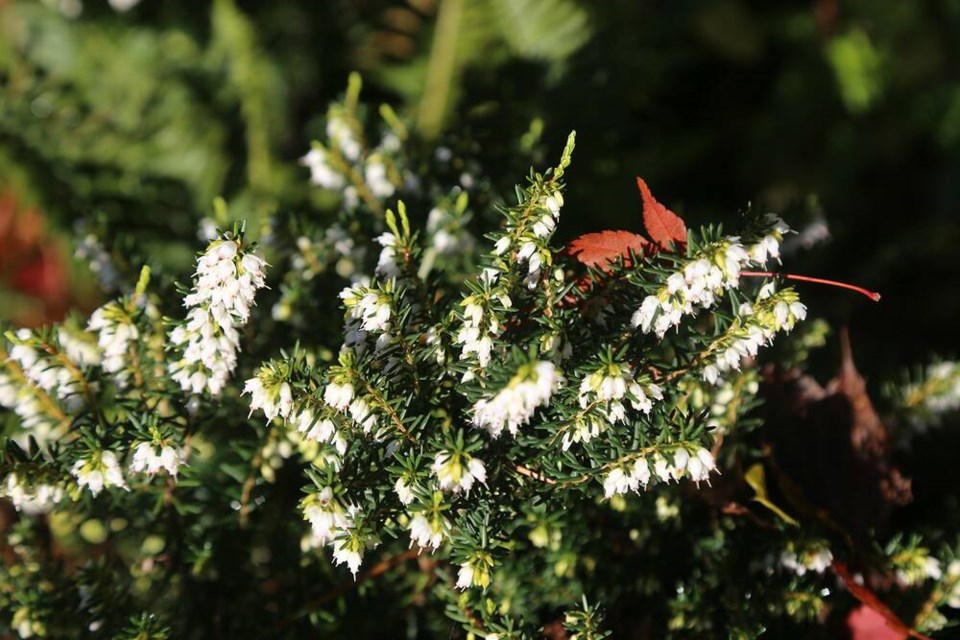“The problem is the solution” is a foundational principle of permaculture that has on multiple occasions, solved more than one perceived problem in our landscape.
Three years ago, when we were installing a food forest pathway around our garden, I was mindful of the 75-year-old laurel hedge that pens in our embedded wire fence. The three-metre deep hedge is a fortress of sorts – an adopted habitat for several species of small mammals, birds, bees and all manner of insects. A complex web of life thrives in the dense interior branches, in the leaf litter and in the soil ecosystem.
The heavy spring and summer traffic in and out of the hedge deposited a mess of twigs, dirt balls and detritus atop the “tidy” pea gravel path, which while delightful, seriously muddied-up the classical English garden vibe I was aiming for.
After considerable deliberation and research, we decided to border the gravel path at ground level, with snow white Erica X darleyensus “Alba,” an inexpensive winter white heath (heather) that blooms brilliant silvery white against lime green foliage from late October through May. For interest, we alternated hardy heath and our favourite native sword fern three-to-one along both sides of the path, and up tight against the hedge.
By year two, the heath and ferns had closed gaps between them, growing tall enough to form a wind-proof barrier to keep organic litter inside the hedge, and many natural predators out. We are delighted that, during the cold dark months of winter, what was once a dark and uninteresting monoculture now offers layers of contrast and texture, punctuated by masses of reflective white blooms.
A heartwarming bonus has been a marked increase in the number and species of birds and insects nesting and foraging in the laurel year-round, but the very best gift that the heath solution delivered is an incalculable increase in availability of food and zoopharmacognosy (plant medicine) for endangered native bees when they appear during the early blossom-barren months of spring.
There are hundreds of species of native bees in Canada that have co-evolved biologically with native plants over millions of years. Biodiversity lost to urban, industrial and agricultural development threatens not only native bees’ future, but ours. Consider that solitary native species like mason bees visit up to 2,000 flowers per day and pollinate at more than 90-per-cent efficiency, compared to their non-native honey bee cousins performing at a considerably lower rate.
Nectar sourced from heaths and heathers, as it turns out, is rich in the phytochemical callulene, which is used by bees for defence against a dangerous insect gut parasite. Researchers in the United Kingdom have highlighted the importance of protecting natural highland ecosystems rich in heaths and heathers, to support bee populations.
In Canadian cities, where winters are long and cold, and many of our urban plantings are non-native and/or incompatible with native insects, we can do our part to advocate for native bee health. In our particular neighborhood, during late March or early April when native mason bees emerge from their cocoons, there are few to no flowers in bloom to feed them. I take comfort then, that our newly established heathers and heaths have become a dependable source of nourishment.
This year, long into the early days of June, there was a palpable hum along the shaded pathway as thousands of bees and other pollinators feasted on heath flowers below, and emerging flowering vines above. In October, when most other blooms have faded, the heath begins blooming again, offering a final gift of sustenance before the frost.
Laura Marie Neubert is a West Vancouver-based urban permaculture designer. Follow her on Instagram @upfrontandbeautiful, learn more about permaculture by visiting her Upfront & Beautiful website or email your questions to her here.
For a taste of permaculture, watch the video below:



